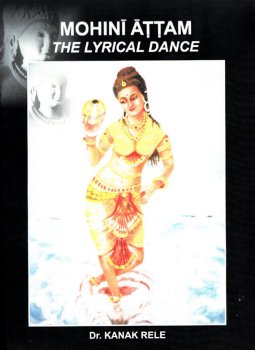
|   |

|   |
‘Mohiniattam- The Lyrical Dance’ by Dr. Kanak Rele - Vijay Shankar e-mail: vijaydance@gmail.com May 3, 2013  Renowned Mohiniattam dancer and dance educationist Dr. Kanak Rele has
now released the second edition of her book ‘Mohiniattam -The Lyrical
Dance’ after the first was released in 1992. This book covers the
‘marga’ tradition set by the Natya Shastra and the subsequent texts as
applicable to the contemporary classical or ‘desi’ dance styles in
general and Mohiniattam in particular. This book is the first ‘shastra’
based book on Mohiniattam which also brings to the fore its exquisitely
lyrical qualities both physical as well as psychological. Renowned Mohiniattam dancer and dance educationist Dr. Kanak Rele has
now released the second edition of her book ‘Mohiniattam -The Lyrical
Dance’ after the first was released in 1992. This book covers the
‘marga’ tradition set by the Natya Shastra and the subsequent texts as
applicable to the contemporary classical or ‘desi’ dance styles in
general and Mohiniattam in particular. This book is the first ‘shastra’
based book on Mohiniattam which also brings to the fore its exquisitely
lyrical qualities both physical as well as psychological.In the foreword, veteran arts critic and scholar Dr. KapilaVatsyayan says, “Her book ‘Mohiniattam: The Lyrical Dance’ first published in 1992 was received enthusiastically. It is a matter of great delight to know that a second is now being released. During this period, Kanak Rele has probed deeper into the historical, the ‘shastric’ as also the ‘prayogic’ dimension of this art form. This is evident in her work both as dancer as also teacher and trainer. Of particular significance is her engagement with analysis of movement. The first edition had analyzed movements through graphic notations. This notation system of analysis is different from the Laban or Benish system. When Kanak Rele came to me in June last year and showed me her work I was delighted and I wrote in hand the following. Wonderful, welcome work. Movement analysis and its graphic notation is an important tool for understanding and analysis. Kanakji's work is pioneering work. Congratulations and blessings.” In the eight chapters, Kanak covers a wide spectrum, commencing with the dance of enchantment, Mohiniattam, the ideals of Indian art, dance 'marga' and 'desi', history of Kerala, its theatrical arts and Mohiniattam, the essence of Mohiniattam, in quest of amruta of Mohiniattam and lastly the chapter dealing with the performing and choreography of Mohiniattam. The author covers a broad based outlook on dance pertaining to the technical, historical, social, religious and spiritual aspect. Kanak was initiated into dance during her teens and started learning Kathakali from guru ‘Panchali’ Karunakara Panicker and was later on hooked to Mohiniattam when she met guru Rajalakshmi and in1967 realized that there were only a handful of items available in the sketchy repertoire that was being followed and no discernible tradition was available. With a Ford Foundation grant, Kanak was fortunate to make films on the three prima-donnas of yesteryears, namely Kalpuratte Kunju Kutty Amma, Tottacheri Chinnammuamma and Kalyani Kuttyamma. Thus, Kanak derived the technique of Mohiniattam by observing, recording, enumeration and finally analysis and deduction. In 1977, Kanak was awarded Phd from Mumbai University for her doctoral thesis on Mohiniattam that delved deeper into Kerala performing arts, ethno-sociological background and aesthetics. In1983, Kanak met Kavalam Narayana Panikkar who opened the world of ‘Sopanam Sangeetam’ and with his collaboration recreated dance pieces and fresh ones were introduced. Thereby, the repertoire of Mohiniattam has expanded to more than 62 items, the speciality of these items being they are woman-centric, pertaining to the matrilineal character of the Kerala society. Her outstanding choreography also includes dance dramas like Santvani, Kanchan-mrig, Kalyani, Buddha - The Enlightened One, etc. The most notable aspect of the book is ‘body kinetics in dance’ in which the author illustrates the evolution and revolution of movements with appropriate sketches that guides the readers and students on how the dancer should execute the movements while dancing. The highlight of the book is the sketches on ‘nritta karanas’ in Mohiniattam nritta. The karanas in Mohiniattam are not poses for embellishment, rather they are straight away used as adavus or the smallest dance unit which are danced to different patterns. This is the great beauty of Mohiniattam because an overwhelming majority of its advaus (that exist today) can be seen to be karanas performed in the typical Mohiniattam idiom. More than 30 pages of illustrations illustrate varied movements of the body at six different levels and parts of the body like sira (head), griva (neck), vajsa (chest), pasva (side), skandha (shoulder), prstha (back) and kati (waist and hip), etc. It is really creditable as till date no dancer has come up with such vivid illustrations of the varied movements of the body pertaining to all limbs of the body, right from the head till the toe. Another outstanding feature of the book are the musical notations that show how Sopanam sangeetam goes through various ‘akkarams’ and flows spontaneously, creating fine harmony between both music and dance. I have seen several dancers performing Mohiniattam in my career as critic for more than thirty years. While most of them have their share of elegance which is the quintessential quality of Mohiniattam, I was completely enchanted to see the dancers from Nalanda executing swaying movements amazingly to the extent that I almost felt intoxicated as the sway would be in a complete full circle creating a fine visual impact, without disturbing the rhythm, the elegance and the lyrical quality of Mohiniattam, for which the entire credit goes to Dr. Kanak Rele. MOHINIATTAM- THE LYRICAL DANCE by Dr. Kanak Rele Publisher: Nalanda Dance Research Centre, Mumbai Pages: 380 - Hardbound Price: Rs.1500 
Post your comment Unless you wish to remain anonymous, please provide your name and email id when you use the Anonymous profile in the blog to post a comment. All appropriate comments posted in the blog will also be featured in the site. |